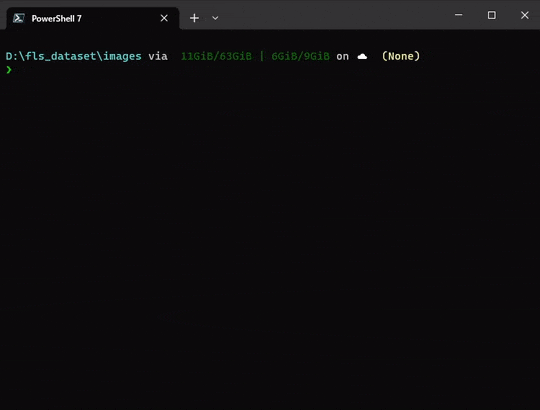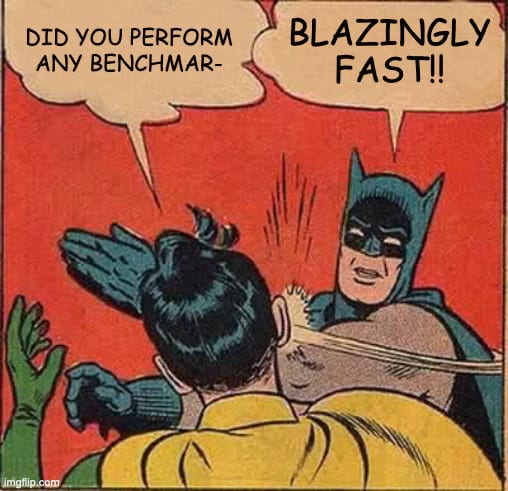31 releases
| 0.7.6 | Aug 8, 2024 |
|---|---|
| 0.7.5 | Jul 2, 2024 |
| 0.7.4 | May 27, 2024 |
| 0.7.2 | Mar 9, 2024 |
| 0.3.1 | Feb 24, 2023 |
#423 in Text processing
1,746 downloads per month
Used in quiet-stroll
43KB
465 lines
f[rame]ls
Description
framels project is intent to deliver a ls command inspired by bls from Buf Compagnie or more recently rvls from RV.
User Guide
The user guide is here.
Installation
Pre-compile bin
You can download the last version https://github.com/forticheprod/fls/releases.
Windows
Support Windows 10 x86
Linux
Support current linux distro tested Fedora 37, Centos 7, Manjaro 22
From Cargo
You can install via https://crates.io/
Run cargo install framels
Usage
Help
Run fls --help
basic_listing
Run fls to list your current directory.

$ touch aaa.001.tif aaa.002.tif aaa.003.tif aaa.004.tif aaa.005.tif foo_bar.exr
$ fls
foo_bar.exr
aaa.***.tif@1-5
Run fls /path/of/directory/ to list a specific directory.
Exemple with the sample set big at the root level of the repo
$ fls samples/big/
RenderPass_Pcam_1_*****.exr@0-96
RenderPass_Beauty_1_*****.exr@0-96
RenderPass_IndDiffuse_1_*****.exr@0-96
RenderPass_Ncam_1_*****.exr@0-41,43-96
RenderPass_Specular_1_*****.exr@0-96
RenderPass_Id_1_*****.exr@0-96
RenderPass_Occlusion_1_***.exr@74
RenderPass_Reflection_1_*****.exr@0-96
RenderPass_SpecularRim_1_*****.exr@0-96
RenderPass_Ncam_1_00042.exr.bkp
RenderPass_DiffuseKey_1_*****.exr@0-96
RenderPass_Diffuse_1_*****.exr@0-96
RenderPass_Occlusion_1_*****.exr@0-73,75-96
Exr Metadata
Inspired by rvls. You can use -l
Run fls -l to list your current directory and display EXR informations.
Run fls -l /path/of/directory/ to list a specific directory and display EXR informations.
$ fls -l samples/big/
RenderPass_Beauty_1_*****.exr@0-96
RenderPass_Occlusion_1_*****.exr@0-73,75-96
RenderPass_Id_1_*****.exr@0-96
RenderPass_Occlusion_1_***.exr@74
RenderPass_Ncam_1_00042.exr.bkp
RenderPass_SpecularRim_1_*****.exr@0-96
RenderPass_DiffuseKey_1_*****.exr@0-96
RenderPass_Pcam_1_*****.exr@0-96
RenderPass_Reflection_1_*****.exr@0-96
RenderPass_Specular_1_*****.exr@0-96
RenderPass_Diffuse_1_*****.exr@0-96
RenderPass_IndDiffuse_1_*****.exr@0-96
RenderPass_Ncam_1_*****.exr@0-41,43-96
.\samples\big\RenderPass_Beauty_1_00000.exr layer #0 size:Vec2(320, 143); channels:ChannelList { list: [ChannelDescription { name: exr::Text("A"), sample_type: F16, quantize_linearly: false, sampling: Vec2(1, 1) }, ChannelDescription { name: exr::Text("B"), sample_type: F16, quantize_linearly: false, sampling: Vec2(1, 1) }, ChannelDescription { name: exr::Text("G"), sample_type: F16, quantize_linearly: false, sampling: Vec2(1, 1) }, ChannelDescription { name: exr::Text("Plane_Beauty.A"), sample_type: F16, quantize_linearly: false, sampling: Vec2(1, 1) }, ChannelDescription { name: exr::Text("Plane_Beauty.B"), sample_type: F16, quantize_linearly: false, sampling: Vec2(1, 1) }, ChannelDescription { name: exr::Text("Plane_Beauty.G"), sample_type: F16, quantize_linearly: false, sampling: Vec2(1, 1) }, ChannelDescription { name: exr::Text("Plane_Beauty.R"), sample_type: F16, quantize_linearly: false, sampling: Vec2(1, 1) }, ChannelDescription { name: exr::Text("R"), sample_type: F16, quantize_linearly: false, sampling: Vec2(1, 1) }, ChannelDescription { name: exr::Text("Spheres_Beauty.A"), sample_type: F16, quantize_linearly: false, sampling: Vec2(1, 1) }, ChannelDescription { name: exr::Text("Spheres_Beauty.B"), sample_type: F16, quantize_linearly: false, sampling: Vec2(1, 1) }, ChannelDescription { name: exr::Text("Spheres_Beauty.G"), sample_type: F16, quantize_linearly: false, sampling: Vec2(1, 1) }, ChannelDescription { name: exr::Text("Spheres_Beauty.R"), sample_type: F16, quantize_linearly: false, sampling: Vec2(1, 1) }], bytes_per_pixel: 24, uniform_sample_type: Some(F16) }
.\samples\big\RenderPass_Occlusion_1_00000.exr layer #0 size:Vec2(320, 139); channels:ChannelList { list: [ChannelDescription { name: exr::Text("A"), sample_type: F16, quantize_linearly: false, sampling: Vec2(1, 1) }, ChannelDescription { name: exr::Text("B"), sample_type: F16, quantize_linearly: false, sampling: Vec2(1, 1) }, ChannelDescription { name: exr::Text("G"), sample_type: F16, quantize_linearly: false, sampling: Vec2(1, 1) }, ChannelDescription { name: exr::Text("R"), sample_type: F16, quantize_linearly: false, sampling: Vec2(1, 1) }], bytes_per_pixel: 8, uniform_sample_type: Some(F16) }
.\samples\big\RenderPass_Id_1_00000.exr layer #0 size:Vec2(140, 52); channels:ChannelList { list: [ChannelDescription { name: exr::Text("A"), sample_type: F16, quantize_linearly: false, sampling: Vec2(1, 1) }, ChannelDescription { name: exr::Text("B"), sample_type: F16, quantize_linearly: false, sampling: Vec2(1, 1) }, ChannelDescription { name: exr::Text("G"), sample_type: F16, quantize_linearly: false, sampling: Vec2(1, 1) }, ChannelDescription { name: exr::Text("R"), sample_type: F16, quantize_linearly: false, sampling: Vec2(1, 1) }], bytes_per_pixel: 8, uniform_sample_type: Some(F16) }
.\samples\big\RenderPass_Occlusion_1_074.exr layer #0 size:Vec2(320, 156); channels:ChannelList { list: [ChannelDescription { name: exr::Text("A"), sample_type: F16, quantize_linearly: false, sampling: Vec2(1, 1) }, ChannelDescription { name: exr::Text("B"), sample_type: F16, quantize_linearly: false, sampling: Vec2(1, 1) }, ChannelDescription { name: exr::Text("G"), sample_type: F16, quantize_linearly: false, sampling: Vec2(1, 1) }, ChannelDescription { name: exr::Text("R"), sample_type: F16, quantize_linearly: false, sampling: Vec2(1, 1) }], bytes_per_pixel: 8, uniform_sample_type: Some(F16) }
Not an exr
.\samples\big\RenderPass_SpecularRim_1_00000.exr layer #0 size:Vec2(320, 143); channels:ChannelList { list: [ChannelDescription { name: exr::Text("A"), sample_type: F16, quantize_linearly: false, sampling: Vec2(1, 1) }, ChannelDescription { name: exr::Text("B"), sample_type: F16, quantize_linearly: false, sampling: Vec2(1, 1) }, ChannelDescription { name: exr::Text("G"), sample_type: F16, quantize_linearly: false, sampling: Vec2(1, 1) }, ChannelDescription { name: exr::Text("R"), sample_type: F16, quantize_linearly: false, sampling: Vec2(1, 1) }], bytes_per_pixel: 8, uniform_sample_type: Some(F16) }
.\samples\big\RenderPass_DiffuseKey_1_00000.exr layer #0 size:Vec2(320, 143); channels:ChannelList { list: [ChannelDescription { name: exr::Text("A"), sample_type: F16, quantize_linearly: false, sampling: Vec2(1, 1) }, ChannelDescription { name: exr::Text("B"), sample_type: F16, quantize_linearly: false, sampling: Vec2(1, 1) }, ChannelDescription { name: exr::Text("G"), sample_type: F16, quantize_linearly: false, sampling: Vec2(1, 1) }, ChannelDescription { name: exr::Text("R"), sample_type: F16, quantize_linearly: false, sampling: Vec2(1, 1) }], bytes_per_pixel: 8, uniform_sample_type: Some(F16) }
.\samples\big\RenderPass_Pcam_1_00000.exr layer #0 size:Vec2(320, 143); channels:ChannelList { list: [ChannelDescription { name: exr::Text("A"), sample_type: F32, quantize_linearly: false, sampling: Vec2(1, 1) }, ChannelDescription { name: exr::Text("B"), sample_type: F32, quantize_linearly: false, sampling: Vec2(1, 1) }, ChannelDescription { name: exr::Text("G"), sample_type: F32, quantize_linearly: false, sampling: Vec2(1, 1) }, ChannelDescription { name: exr::Text("R"), sample_type: F32, quantize_linearly: false, sampling: Vec2(1, 1) }], bytes_per_pixel: 16, uniform_sample_type: Some(F32) }
.\samples\big\RenderPass_Reflection_1_00000.exr layer #0 size:Vec2(320, 143); channels:ChannelList { list: [ChannelDescription { name: exr::Text("A"), sample_type: F16, quantize_linearly: false, sampling: Vec2(1, 1) }, ChannelDescription { name: exr::Text("B"), sample_type: F16, quantize_linearly: false, sampling: Vec2(1, 1) }, ChannelDescription { name: exr::Text("G"), sample_type: F16, quantize_linearly: false, sampling: Vec2(1, 1) }, ChannelDescription { name: exr::Text("R"), sample_type: F16, quantize_linearly: false, sampling: Vec2(1, 1) }], bytes_per_pixel: 8, uniform_sample_type: Some(F16) }
.\samples\big\RenderPass_Specular_1_00000.exr layer #0 size:Vec2(320, 143); channels:ChannelList { list: [ChannelDescription { name: exr::Text("A"), sample_type: F16, quantize_linearly: false, sampling: Vec2(1, 1) }, ChannelDescription { name: exr::Text("B"), sample_type: F16, quantize_linearly: false, sampling: Vec2(1, 1) }, ChannelDescription { name: exr::Text("G"), sample_type: F16, quantize_linearly: false, sampling: Vec2(1, 1) }, ChannelDescription { name: exr::Text("R"), sample_type: F16, quantize_linearly: false, sampling: Vec2(1, 1) }], bytes_per_pixel: 8, uniform_sample_type: Some(F16) }
.\samples\big\RenderPass_Diffuse_1_00000.exr layer #0 size:Vec2(320, 143); channels:ChannelList { list: [ChannelDescription { name: exr::Text("A"), sample_type: F16, quantize_linearly: false, sampling: Vec2(1, 1) }, ChannelDescription { name: exr::Text("B"), sample_type: F16, quantize_linearly: false, sampling: Vec2(1, 1) }, ChannelDescription { name: exr::Text("G"), sample_type: F16, quantize_linearly: false, sampling: Vec2(1, 1) }, ChannelDescription { name: exr::Text("R"), sample_type: F16, quantize_linearly: false, sampling: Vec2(1, 1) }], bytes_per_pixel: 8, uniform_sample_type: Some(F16) }
.\samples\big\RenderPass_IndDiffuse_1_00000.exr layer #0 size:Vec2(320, 143); channels:ChannelList { list: [ChannelDescription { name: exr::Text("A"), sample_type: F16, quantize_linearly: false, sampling: Vec2(1, 1) }, ChannelDescription { name: exr::Text("B"), sample_type: F16, quantize_linearly: false, sampling: Vec2(1, 1) }, ChannelDescription { name: exr::Text("G"), sample_type: F16, quantize_linearly: false, sampling: Vec2(1, 1) }, ChannelDescription { name: exr::Text("R"), sample_type: F16, quantize_linearly: false, sampling: Vec2(1, 1) }], bytes_per_pixel: 8, uniform_sample_type: Some(F16) }
.\samples\big\RenderPass_Ncam_1_00000.exr layer #0 size:Vec2(320, 143); channels:ChannelList { list: [ChannelDescription { name: exr::Text("A"), sample_type: F16, quantize_linearly: false, sampling: Vec2(1, 1) }, ChannelDescription { name: exr::Text("B"), sample_type: F16, quantize_linearly: false, sampling: Vec2(1, 1) }, ChannelDescription { name: exr::Text("G"), sample_type: F16, quantize_linearly: false, sampling: Vec2(1, 1) }, ChannelDescription { name: exr::Text("R"), sample_type: F16, quantize_linearly: false, sampling: Vec2(1, 1) }], bytes_per_pixel: 8, uniform_sample_type: Some(F16) }
Recursive
You can use a recursive approch of the directory and sub-folder
You can use -r
Run fls -r /path/of/directory/ to list a specific directory and his
subfolder
$ fls -r .\samples\
.\samples\big\RenderPass_Diffuse_1_*****.exr@0-96
.\samples\big\RenderPass_Ncam_1_00042.exr.bkp
.\samples\big\RenderPass_DiffuseKey_1_*****.exr@0-96
.\samples\big\RenderPass_Occlusion_1_*****.exr@0-73,75-96
.\samples\big\RenderPass_Occlusion_1_***.exr@74
.\samples\small\foo_bar.exr
.\samples\big\RenderPass_SpecularRim_1_*****.exr@0-96
.\samples\big\RenderPass_Pcam_1_*****.exr@0-96
.\samples\big\RenderPass_Ncam_1_*****.exr@0-41,43-96
.\samples\small
.\samples\big
.\samples\big\RenderPass_Id_1_*****.exr@0-96
.\samples\big\RenderPass_Specular_1_*****.exr@0-96
.\samples\big\RenderPass_Beauty_1_*****.exr@0-96
.\samples
.\samples\big\RenderPass_IndDiffuse_1_*****.exr@0-96
.\samples\big\RenderPass_Reflection_1_*****.exr@0-96
.\samples\small\aaa.***.tif@1-5
Tree
You can use a tree approch of the directory and sub-folder
You can use -t
Always use -r to use the tree mode.
Run fls -t -r /path/of/directory/ to list a specific directory and his
subfolder
$ fls -t -r .\samples\
┗
┗ samples
┗ big
┗ RenderPass_Beauty_1_*****.exr@0-96
┗ RenderPass_DiffuseKey_1_*****.exr@0-96
┗ RenderPass_Diffuse_1_*****.exr@0-96
┗ RenderPass_Id_1_*****.exr@0-96
┗ RenderPass_IndDiffuse_1_*****.exr@0-96
┗ RenderPass_Ncam_1_*****.exr@0-41,43-96
┗ RenderPass_Ncam_1_00042.exr.bkp
┗ RenderPass_Occlusion_1_*****.exr@0-73,75-96
┗ RenderPass_Occlusion_1_***.exr@74
┗ RenderPass_Pcam_1_*****.exr@0-96
┗ RenderPass_Reflection_1_*****.exr@0-96
┗ RenderPass_SpecularRim_1_*****.exr@0-96
┗ RenderPass_Specular_1_*****.exr@0-96
┗ mega
┗ response_1689510067951.json
┗ small
┗ aaa.***.tif@1-5
┗ foo_bar.exr
Benchmarks
Using the sample big, some time comparaison with rvls, lsseq or lss.
Here benchmarks done with hyperfine with a warmup of 3 iterations
Simple file listing
| Tool | fls 4.0.0 |
rvls 2023.0.1 |
lsseq -l |
lss |
|---|---|---|---|---|
| Time | 4.7 ms | 23.3 ms | 33.5 ms | 41.8 ms |
hyperfine -N --warmup 3 'target/release/fls ./samples/big/'
Benchmark 1: target/release/fls ./samples/big/
Time (mean ± σ): 4.7 ms ± 0.7 ms [User: 4.9 ms, System: 1.7 ms]
Range (min … max): 4.3 ms … 11.5 ms 560 runs
hyperfine --warmup 3 '~/Downloads/rv-centos7-x86-64-2023.0.1/bin/rvls ./samples/big/'
Benchmark 1: ~/Downloads/rv-centos7-x86-64-2023.0.1/bin/rvls ./samples/big/
Time (mean ± σ): 23.3 ms ± 7.1 ms [User: 20.1 ms, System: 2.3 ms]
Range (min … max): 19.4 ms … 51.5 ms 75 runs
Exr reading
| Tool | fls -l |
rvls -l |
|---|---|---|
| Time | 7.3 ms | 95.8 ms |
Issues and PR
Issues, feedback and PR are welcome
Some hard rules, i won't trade off
- Windows compatible
- Speed
- UTF8 friendly
- Pure Rust
Thanks
Thanks to:
- Ben Legros for the indirect mentorship over a beer ( or many )
- Djl for the idea
- Tcherno
- Mercenaries Eng for the best render engine ( samples/big render with Guerilla render )
Dependencies
~9.5MB
~149K SLoC
